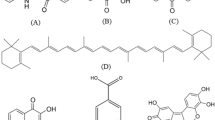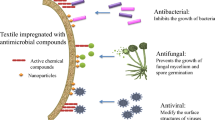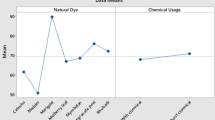Abstract
In this study, cotton fabrics were chemically attached with nano-chitosan using cyanuric chloride as an anchor in order to enhance its dyeability towards direct dyes and its bacterial resistance. Low molecular weight chitosans were synthesized by hydrolysing chitosan by nitrous acid. The molecular weight was assessed viscometrically. The particle size of chitosans was reduced by ionic gelation technique, and the sizes were measured using particle size analyser. The nano-sized particles were then attached to cotton which was reacted to cyanuric chloride earlier. FTIR spectra and scanning electron microphotographs of the samples were analysed. The treated and untreated cotton samples were dyed using three direct dyes. The dye absorption of the treated samples in the absence of salt was found to be much higher compared with the untreated samples dyed in the presence of salt and could also improve wash fastness. The treated cotton samples showed improved antimicrobial behaviour as evaluated by agar diffusion method. Attachment of nano-chitosan to cotton did not adversely affect the feel of the fabric as found in case of unmodified cotton.












Similar content being viewed by others
References
Mousa Sadeghi-Kiakhani, Ali Reza Tehrani-Bagha, Siyamak Safapour. Cellulose 25(1), 883–893 (2017)
S. Akbari, A. Asayesh, S. Khaliliazar, M. Razipour, N. Esmaeeli, in Hand book of Natural Fibres, Elsevier, vol. 2: Processing and Applications, Chapter 13 (2020)
D.P. Chattopadhyay, Indian J. Fibre Text. Res. 26, 108–115 (2001)
P.K. Dutta, J. Dutta, V.S. Tripathy, J. Sci. Ind. Res. 63, 20–31 (2004)
M.S. Inamdar, D.P. Chattopadhyay, Man-Made Text. India 49(6), 211–216 (2006)
K. Divya, M.S. Jisha, Environ. Chem. Lett. 16, 101–112 (2018)
S. Houshyar, S.H. Amirshahi, Iran. Polym. J. 11(5), 259–301 (2002)
M.A. Rahman Bhuiyan, A. Shaid, M.A. Khan, Chem. Mater. Eng. 2(4), 96–100 (2014)
J. Safari, Z. Zarnegar, Z.A. Jazini, M. Sadeghi, Catal. Commun. 77, 108 (2016)
Y.H. Khan, A. Islam, A. Sarwar, N. Gull, S.M. Khan, M.A. Munawar, S. Zia, A. Sabir, M. Shafiq, T. Jamil, Carbohydr. Polym. 146, 131 (2016)
V. Ravishankar Rai, A. Jamuna Bai, in Formatex, Microbiology Series, vol. 1, no. 3, ed. by A. Méndez-Vilas (Spain, 2011), pp. 197–209
A.K. Gupta, R.R. Naregalkar, V.D. Vaidya, M. Gupta, Nanomedicine (London) 2(1), 23–29 (2007)
A. Grenha, J. Drug Target. 20(4), 291–300 (2010)
W. Tiyaboonchai, Naresuan Univ. J. 11(3), 51–66 (2003)
A. Sailaja, P. Amareshwar, P. Chakravarty, Int. J. Pharm. Pharm. Sci. 3(Suppl 2), 45–50 (2011)
D. Koilparambil, J. Shanavas, Environ. Chem. Lett. 16, 101–112 (2018)
E. Rochima, S.Y. Azhary, R.I. Pratama, C. Panatarani, I.M. Joni, Mater. Sci. Eng. 193, 012043 (2017)
N. Najafzadeh, S. Habibi, M.A. Ghasri, J. Eng. Fibers Fabr. 13, 2 (2018)
C. Debapriya, M.S. Inamdar, Indian J. Fibre Text. Res. 38(1), 14–21 (2013)
M. Hosseini, M. Montazer, R. Damerchely, J. Eng. Fibers Fabr. 8, 3 (2013)
D.P. Chattopadhyay, M.S. Inamdar, Int. J. Polym. Sci. 2010, 7–8 (2010)
S. Sudha, V.R. Giridev, R. Neelkandan, M.S. Kumar, J. Text. Assoc. 64, 165–166 (2006)
E. Pinho, L. Magalhães, M. Henriques, O. Oliveira, Ann. Microbiol. 61, 493–498 (2011)
K. Vellingiri, T. Ramachandran, M. Senthilkumar, Nanosci. Nanotechnol. 3(4), 75–89 (2013)
Author information
Authors and Affiliations
Corresponding author
Additional information
Publisher's Note
Springer Nature remains neutral with regard to jurisdictional claims in published maps and institutional affiliations.
Rights and permissions
About this article
Cite this article
Chattopadhyay, D.P., Surati, D. Enhancing Dyeability and Antibacterial Feature of Cotton Through Nano-chitosan Attachment. J. Inst. Eng. India Ser. E 101, 175–184 (2020). https://doi.org/10.1007/s40034-020-00171-4
Received:
Accepted:
Published:
Issue Date:
DOI: https://doi.org/10.1007/s40034-020-00171-4




